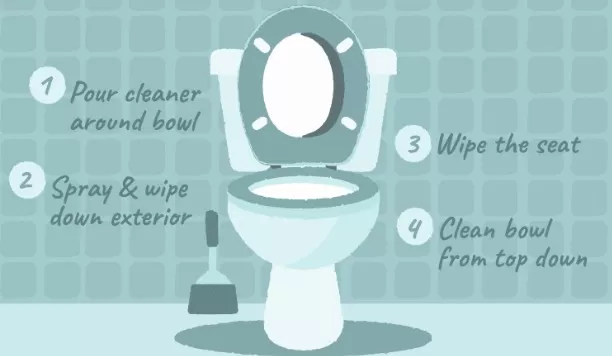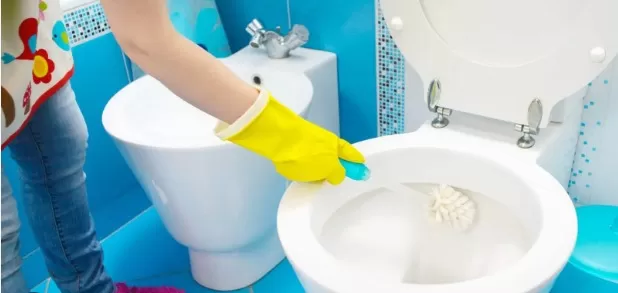Rediscover the sparkling cleanliness of your porcelain throne with the right cleaning techniques. Learn how to bring back the gleam and maintain a pristine toilet in your bathroom.
Mastering the Art of Thorough Toilet Cleaning

Cleaning the toilet, a dreaded household chore, may seem like dirty work, but it’s a vital task for hygiene and ensuring the longevity of the fixture, especially in areas with hard water.
While we eagerly await the invention of self-cleaning toilets, for now, it remains an unavoidable duty. The silver lining is that cleaning a toilet is not as challenging as it may seem.
Here’s a step-by-step guide to help you achieve a thorough clean.
Tools and Materials:- rubber gloves– Disinfectant- Scrubbing brush- Pumice stone- Antibacterial spray- Paper towels or clean rags.
Step 1: Prepare Yourself and Drain the ToiletBefore you begin, put on protective gear, including rubber gloves.
Consider wearing an apron and protective eyewear as well, given the use of harsh chemicals. Next, drain the toilet by either turning off the water supply and flushing or wedging the float valve to prevent automatic refilling.
Step 2: Disinfect and Scrub the BowlLift the toilet seat and apply disinfectant around the rim and sides of the bowl, allowing it to flow down slowly.
If you have hard water, choose a disinfectant with lime scale removal properties or use a separate lime scale remover. Use a stiff, plastic-bristled brush to scrub the entire bowl, and let the cleaner sit.
Step 3: Tackle Tough Stains with a Pumice StoneFor stubborn stains and lime scale deposits, use a wet pumice stone to scrub the affected areas of the ceramic bowl.
The pumice stone is an effective tool for various types of discoloration.
Step 4: Clean the Exterior SurfacesWhile the disinfectant does its work, focus on the exterior surfaces.
Apply an antibacterial spray and use a clean rag or paper towels to wipe them down thoroughly. Pay close attention to the seat hinge, known for accumulating grime.
Don’t forget to spray and wipe both sides of the lid and seat as well.
Step 5: Revisit the Toilet BowlTake your scrubbing brush and give the toilet bowl another thorough scrub.
Concentrate your efforts on the area beneath the rim and down into the U-bend. Once finished, restore the water supply or unplug the float valve.
Flush the toilet to rinse off any remaining disinfectant.
Step 6: Clean and Store the BrushRinse off the bristle brush to ensure it’s ready for use again next week.
By following these steps, you’ll master the art of thorough toilet cleaning, keeping your toilet clean, hygienic, and in optimal condition.
Tips for Maintaining a Clean and Fresh Toilet

Regular Cleaning Schedule
Establish a routine cleaning schedule for your toilet to prevent dirt and grime buildup. Set aside specific days or times each week to give your toilet a thorough cleaning.
Avoid Harsh Chemicals
While it’s important to use effective cleaning agents, try to avoid using harsh chemicals that can damage the toilet’s surfaces or harm the environment. Look for eco-friendly and non-toxic cleaning products.
Vinegar Solution:
Create a natural cleaning solution by mixing equal parts of water and vinegar. This solution can be used to clean the toilet bowl, remove stains, and neutralize odors.
Brush and Flush:
After using the toilet brush to clean the bowl, always remember to flush the toilet to remove any remaining cleaning agents and keep the bowl fresh.
Regularly Replace Toilet Brushes
Over time, toilet brushes can accumulate bacteria and become less effective.
Replace your toilet brush every few months to ensure optimal cleaning results.
Preventive Measures
Encourage everyone in your household to practice good toilet habits, such as avoiding excessive toilet paper usage and not flushing items that can clog the toilet.
Proper Ventilation
Adequate ventilation in the bathroom can help reduce humidity and prevent mold and mildew growth.Open a window or use an exhaust fan while cleaning the toilet and after each use.
Deep Cleaning Sessions
In addition to regular maintenance, schedule periodic deep cleaning sessions to thoroughly sanitize the toilet and remove any hidden dirt or stains.
Quick Fixes for Common Toilet Issues

Clogged Toilet
If your toilet becomes clogged, try using a plunger to dislodge the blockage. Apply firm and consistent pressure while plunging, and repeat the process if necessary. If the clog persists, consider using a toilet auger or contacting a professional plumber.
Running Toilet
A running toilet can waste water and lead to higher utility bills. Check the flapper valve in the tank to ensure it is properly sealing. If it’s damaged or worn out, replace it. Adjusting the water level in the tank or replacing a faulty fill valve may also solve the issue.
Leaking Toilet
A leaking toilet can result in water damage and increased water consumption. Check for visible leaks around the base of the toilet and the water supply line. Replace any damaged or worn-out seals or call a professional plumber for assistance.
Weak Flush
If your toilet has a weak flush, it may not be getting enough water or there may be an issue with the flush valve or clogged rim holes. Ensure that the water supply is fully open and the flapper valve is functioning correctly. Cleaning the rim holes with a small brush can improve flushing performance.
Foul Odors
Persistent odors in the toilet can be caused by bacteria or mold. Regularly clean the toilet bowl, tank, and surfaces with disinfectants or natural cleaning agents to eliminate odors. Using toilet bowl tablets or drops specifically designed to freshen the toilet can also help.
Remember, if you encounter complex or recurring issues with your toilet, it’s always recommended to seek professional assistance from a plumber to ensure proper repair and maintenance.
*The information is for reference only.